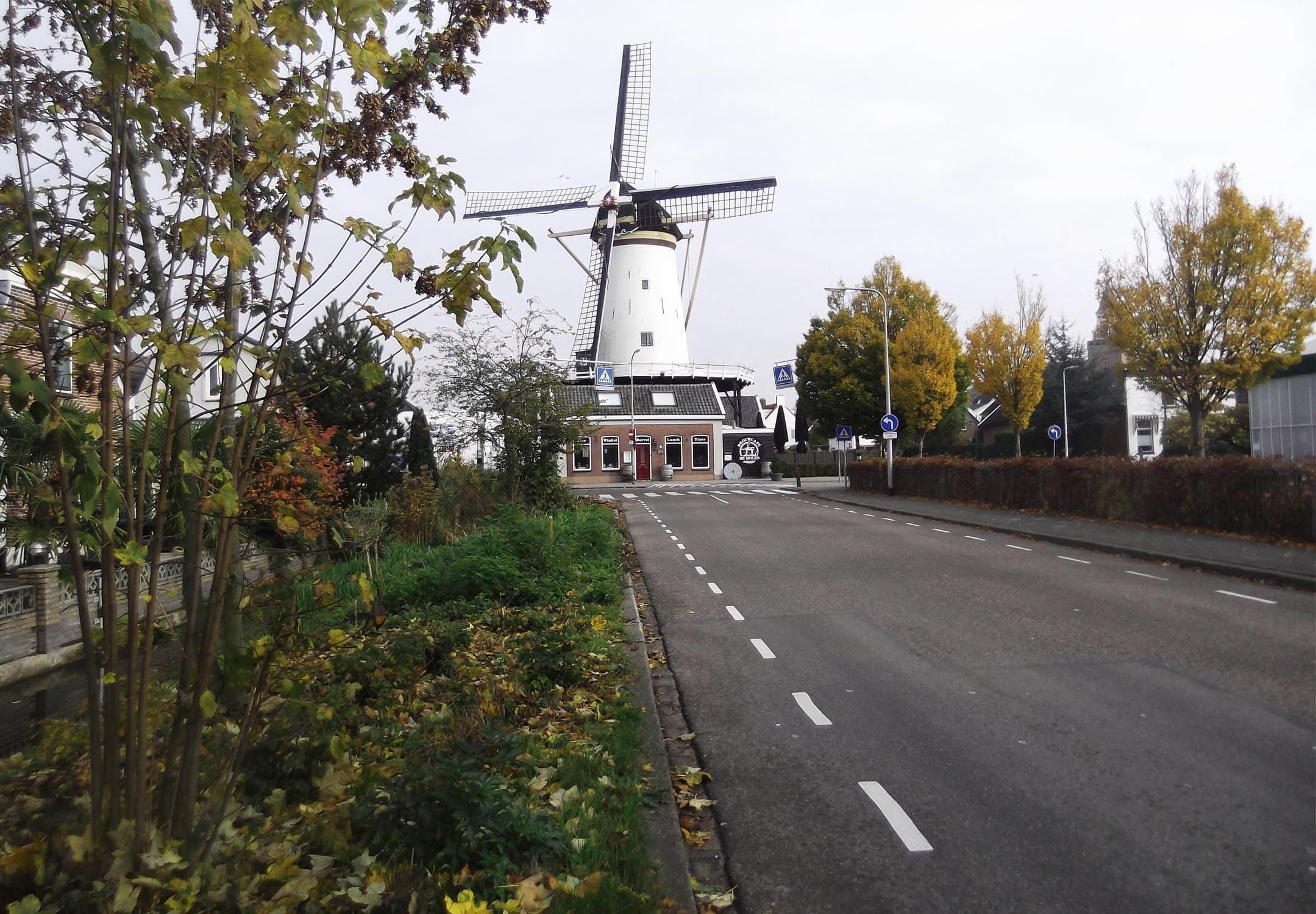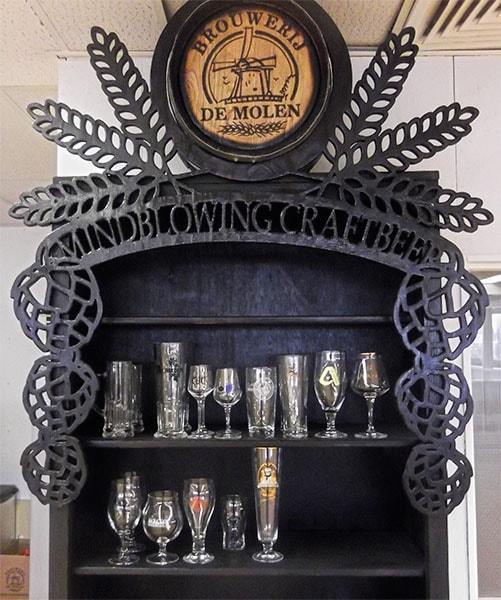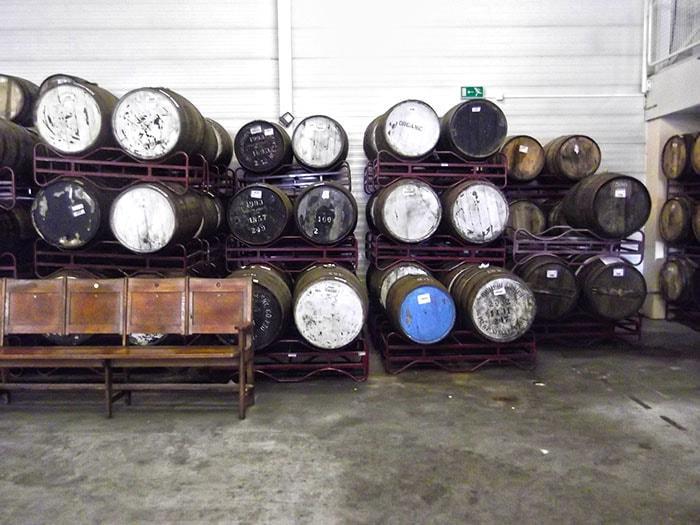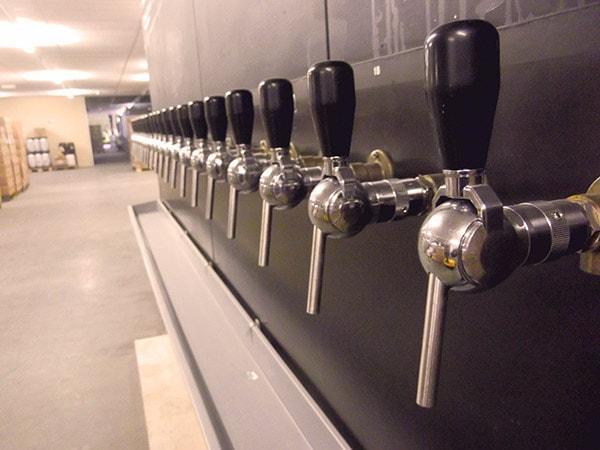De Molen
Back And Forth
Escrito por Jesús Olano—Fotos por Jesús Olano; Bodegraven (Netherlands), 28/02/2017 beerbayOU

The windmill De Arkduif (ark dove) stands out from the surrounding houses in the West of Bodegraven, a small city shaped by its characteristics water channels and located in the heart of Netherlands green belt. In this mill, now turned into a restaurant, Menno Olivier founded in 2004 what later it would turn to be known as Brouwerij De Molen, considered best brewery in the Netherlands since 2008 and one of the top breweries in the world, especially if we talk about Stouts and Imperial Stouts. In 2006, Menno became friend with John Brus, the other creative force behind De Molen. John started homebrewing when he was 17 years old, and in 2009 he definitely became part of De Molen.
The mill soon became too small, so De Molen moved to an industrial building 100 meters away. As demand for De Molen's beers thrived, in 2016 they had to expand their current building with the objective to reach a 25.000 Hl. a year production. In their brand new headquarters, John Brus welcomed us to show us their new facilities and talked to us about past present and future.

You started brewing in the old mill—a little mill 100 m. away from here. Was there any tradition in that particular spot or in the city that may have influenced you in the beginning?
John: No. Maybe even all the way round. There was nothing in this village regarding beer or brewing. I think maybe hundreds of years ago, but there is no records of that. And this village is actually part of the Dutch Bible Belt. There is a Bible Belt going from the South West across the country to the North East, and this is part of that, so people are very much against drinking in the village. A lot of people, not everyone, of course, but there is still a very strong religious protestant community. So there was nothing here. Cheese farmers, mainly, and some villagers. But both Menno and me, we are not from Bodegraven. Menno is from Rotterdam and I’m from Delft. Menno started the brewery in 2004. In the mill. But he was the first. And especially some of the names that he used were kind of not appreciated by some people here in the village. But there is not tradition in the village alone regarding brewery. Now there are two breweries, by the way, there is a new one [Merciless Brewing].
So you have made the tradition, a little bit...
John: Yes, we started it. There was however a tradition of homebrewers. It was a small group, and Menno was a member of it. But there were no brewers, no professionals.

And what about Netherlands. Were there a strong tradition here that may have influenced you in the beginnings?
“When De Molen started with this kind of beers, no one did that in Holland. We were the first.”
John: Again, I think we were pioneers in brewing in Holland, if you look at the styles that we made. The brewery started almost at the beginning with English Strong Ales, not so much IPA’s in those days but bitters. A lot of focus on English styles or traditional German styles like Smoked Beers. And in Holland there is a long tradition of brewing for hundreds of years, with a lot of brewing capitals—like the city where I’m from, Delft. I think in the sixteen hundreds there were like 125 brewers, while there was just 10.000 people living there, and we exported a lot. I think we were quite famous. Cities like Delft, Vlaandingen were then quite famous. Export was across provinces, because we weren’t a country yet, so they exported to Utrecht, Brabant, etc. So there is a long tradition of beer culture in Holland which died a little bit in the 1970’s – 1980’s. Since the 1930’s, big breweries like Heineken were taking over small breweries, and shooting them down. So I think around 1980’s there were maybe about 20 breweries in Holland. And soon after the 80’s they started a few new breweries in Holland—microbreweries as we called it on those days—, but they all focused on Belgian styles. Breweries like t’IJ in Amsterdam, it was one of the first microbreweries, but they were all focused in Belgian styles—Blond, Trippel, etc.
But when De Molen started with this kind of beers, no one did that in Holland. We were the first. Even breweries that already existed like Jopen, they were focused on traditional Dutch styles or Belgian styles—nowadays they make stouts and IPA’s. So we were pioneers in Holland as well, not just in the village.
About your names and your artwork. We noticed that in contrast with another craft breweries, you have a trademark label and you never change it, but your names are really different. Names like Hell & Damnation, Blood, Sweat & Tears, Fire & Flames, Heaven & Hell, Beautiful & Ruthless, Moord & Doodslag (Murder & Manslaughter). It sounds more like a catalogue of a heavy metal band. How do you think that this contrast defines the brand?
“We are all about making beer, not about naked ladies or dragons or whatever on the label. This is beer!”
John: It defines the brand absolutely, but we didn’t start that way. When we started we had coloured labels. But they were really ugly. Really, really ugly [John laughs]. They were orange with a red and green square around it and they were all called like Borefts Style—Borefts is slang for Bodegraven. And that’s how we started. But then one moment there was an emergency. We had to make a label very quickly because the beer needed to be transported. So we just made a new label by hand, wrote the name on it and printed it on a printer, and stack the labels on the bottle.

And when we did that, we actually thought: “this is much... better!”. Because you can call the old labels ugly or you can call them different, colourful, but they had no expression, no personality. And now, this is where we are, we are all about making beer, not about naked ladies or dragons or whatever on the label. This is beer! So we give it a name, we tell what is in it, very detailed, with the hop varieties and everything. So it defines absolutey our brand. And the names as well. We are using Dutch proverbs most of the times—for example this is different in Rasputin. We started with the first beer, it was our Trippel, called Heen & Veer—which means Back & Forth. We were still in the mill brewery, but we had our fermentors on the other side of the town.
So you were going back and forth.
John: We were going back and forth with the fermentors. We filled it with wort and drove it to the warehouse where we fermented and took an empty one back. So that was the first time. And we liked the name, and slowly took it. It all happened as an accident, but it’s branding, absolutely. Not thought trough, not by a big branding company thinking about “how should we do this?”. It just happened and we thought “this is a good idea”. And we try to find the names which represent the beer, a little. I mean, like Hell & Damnation, it is what the beer is. It’s strong, it’s black, it’s complex.
You’re right now expanding from brewing 4.500 l. to brew 25.000 l. How does that influence your processes and your style of brewing?
John: I hope it doesn’t. We started brewing in a very small brewery—500l. Then we changed to a 25 Hl. System in 2011. We had a lot of... trouble is not the right word, but we needed to tweak a lot of things in the first year, in order to get back to the flavour we wanted to again. Because that’s a very big step. And with that equipment we could do 5.000 Hl. in a year. By changing small things, getting a few extra fermentors, we managed to produce 7.000 Hl. last year. But still, demand is bigger than production.

When we changed to the bigger brewery, Menno and I said: “OK, this is the final step, this is what we do”. But we didn’t take in account that the craft beer scene would be so explosively growing in the years. So last year, we decided: “we’ll do another growth, again”. Because we like what we do, we like the appreciation we get. And I don’t want to be a brewery that says: “OK, we have this amount of beer, we just raise the prices and people will buy it or not”. This is not what we wanted. Because our goal is actually to show people good beer. And you can only do it if you’re present in shops and bars. They can’t get it, they cannot appreciate it.
“We didn’t take in account that the craft beer scene would be so explosively growing in the years. So last year, we decided: we’ll do another growth, again”
So we decided to grow again, but what we did is not to change the brewhouse. We have the same mash tun, the same lauter tun, we only have got a bigger boiler, a bigger whirpool—which doesn’t influence the brewing process too much—, and we have a whole new vessel. So what we can do now instead of brew once a day, we can brew 4 times a day in 12 h., because we don’t have to go back and forth with the tank. We can do 4 batches a day, that is like 10.000 l. And we have a lot more fermentors. We can even have a license to brew on Saturday. So we didn’t change too much in the whole brewing process, so for us that was an advantage.
You always mention the word experimenting when talking about brewing. That beer is about experimenting and that you brew at least one new beer each month. Do you feel that after these years now you experiment more than before, or the contrary?
John: I’m afraid I have to say that this year we’ve been experimenting less. And there is one big reason for that. Is that we have been changing the brewhouse. We have been a new bottling line. We have expanded the building. We just have it from April this year—I was empty for a few years. And this took a lot of energy and time from the management—from me, Jaco and Menno—, so we didn’t have time for experiment. Also, demand is growing, so everything we could brew more, we had to brew the beers that were demanded. So we didn’t have much time to experiment this year. Same goes for barrel aging beers, we really didn’t have the time to take care of that.

“So it is not about the size. And to me it is also not about who owns it. I don’t care if Lagunitas is owned by Heineken. If they make good beer, they make good beer. And that is what is all about.”
But now we’re finished. We’re almost finished. How we call it in Dutch, the whole growing kick we did it this year, so it costed us experimenting a bit this year. But absolutely we will continue with that. Because we think that is one of the most important parts of the definition of craft beer. Some people think craft beer is to work by hand and brew 200 l. in the weekend. I don’t think there has anything to do with craft beer. And you can make a horrible beer doing that. For me it is about good quality flavourful beer. And it doesn’t matter to me how big your brewery is. I mean, Stone Brewing—in America—, they’re still a good brewery. And it’s huge. Same goes for a few in the states, for example Dogfish Head. And they make high quality beer. So it is not about the size. And to me it is also not about who owns it. I don’t care if Lagunitas is owned by Heineken. If they make good beer, they make good beer. And that is what is all about.
So experimenting is absolutely part of our craft beer definition. Also, collaborating with other breweries and exchanging information and knowledge is absolutely part of it. For me, helping other craft brewers that are starting and that we see potential in them is also a part of it. We’ve been helping a lot of breweries, I would almost say almost worldwide, but also in Holland. Either promoting them or just giving them information, helping them starting up. And that’s part of the craft beer scene, I think.
You started your barrel-aging process back in 2005. What have you learn from this experience?
John: We have, of course, learnt a lot. Simple things, like filling up the barrel completely,—if you don’t do that it will oxidice. All kind of technical things. One of the most important things in the technical side is that we barrel-age our beers in a room which fluctuates in temperature. So if it’s cold, like today it’s like 17 degrees, and if it’s warm, it never goes beyond 30 degrees. If it’s warm outside, it can even go up to 22 degrees in the barrel room. And I think that gives a lot more character to the beers.

But that does have a bad side as well. If there is a problem, it will all go wrong. We through away 1 into every 3 barrels, sometimes they get infected into lactobacteria, and we throw them away. But if we compare it to other breweries that also make nice beers—like La Trappe, that also do some barrel-aging here in Holland—, they keep the temperature at 16 degrees constant. And I think it lacks character then. It still gets the flavour from the barrel, but not as when you do it our way.
What about your collaborations , how had they influenced your style, and what was the most prominent thing you have learnt by collaborating with other breweries?
“To be honest, I think that the most important part of the collaboration is meeting other brewers. Putting the face, just talk to people. And we have never met any asshole in the whole brewing business.”
John: To be honest, I think that the most important part of the collaboration is meeting other brewers. Putting the face, just talk to people. And we have never met any asshole in the whole brewing business. They are always fine guys that you like to share a beer with and you want to talk not just the brew, but about life itself. That’s a very big part for us in the whole brewing collaboration process. Of course we see a lot of things in the world this way. We go everywhere. My last collaboration [Wet & Wild] was with Laugar in the Bask Country. Menno’s last collaboration was in the US. Sometimes we do it together, next week we go to France together. And you see how all the brewers do it. Sometimes just brewing techniques, for example the English techniques are very different than the Belgium. Sometimes solutions for small problems—McGyver kind of things. And all that is very important and it influences the way you work, because you get more flexible yourself.
You started with the Borefts Festival in 2009—and you do a special contest there when you give an ingredient and a style and you have to put it together. Do you use this kind of methods in order to make new recipes for yourselves?
John: It’s a tradition of the festival and for the fun as well. Because Borefts Beer Festival—the first edition—was in 2009. And this first edition was called pre BBF. And BBF was not Borefts Beer festival in those days, it was Bock Beer Festival. Bock Beer Festival is a festival held in Amsterdam around September-October. And this is a festival where, first of all, every brewery that makes beer can go and stand there. And the result is that, in those days early soon in this century, there were lots of small breweries in Holland that they made really bad, bad beer. Always infected and unballanced, there was a horrible beer. And so we were at this festival as well, and we were not allowed to tap our own beer—we hated that. There were just volunteers who didn’t know and just cared about drinking. There were a lot of bad breweries. A lot of the people visiting the festival were stag parties, or just children coming to get drunk.
So this was the most famous festival in Holland—with around 10.000 people per day—, and it was the worst festival you could think of.
Because it was not about beers...
John: Exactly, it was a stupid festival—it’s much better now, by the way. So we said: “we’re not going to join this festival anymore, we’re going to make our own festival”. So, the Friday before our festival started, we made our pre Bock Beer Festival. And that’s why we asked every brewery attending the festival: “brew your own Bock beer”. And that’s how it started. First year every brewery made their own Bock beer and we had our Bock Beer Festival.

And the second year we said: “OK, this is really childish—doing it this way”, so we moved it—one month earlier—, and we changed the name to Borefts Beer Festival. But I liked the idea of people brewing a beer, so the second year we thought on something new, and way on and on... I think the second year we asked everybody to brew our own IPA Vuur & Vlam [Fire & Flames]. So it became a tradition, and that’s what we still do. We try to think of a theme, and then we ask our attending brewers to brew a beer according to the theme.
So how does exactly do you come up with new ideas for beers. Do you have a meeting to throw some kind of brainstorming, or is it that somebody comes with a new idea and then you start developing it?
John: It’s 90% of the time Menno—our brewmaster—who comes up with an idea. He has an idea, and starts thinking about it. And the other 10% is me. I just think of something, talk to Menno and we discuss it. So there is not schedule, there is no organization line. It’s just... you find a nice ingredient or you make a collaboration and you make some traditional style—for example, a traditional Polish beer, Grodziskie—and then you think “oh, we’ve never done that, let’s do it”.
Your brewery is also socially envolved with the local community—you have some mentally handicapped people working with you in the factory. How do you think this contributes to you, both as a company and as a person.
John: It influences the company a lot—in positive ways. First of all, we have a lot of hand that can helps us out with simple jobs, which is perfect for us, of course. Second, most of them have a great personality, and you just have fun. And it also influences us in the growth side—for example, we bought a new bottling line, and the company that manufactured it to us said: “oh yeah, we could put here a machine that will automatically put a pallet of bottles into the machine, and we have another machine that can take out the bottles and put it in boxes”. And we said: “no, we don’t want that, because then the guys don’t have a job”. So we didn’t do that.

So now we have a bottling line where we actually need one more guy than before. But they can keep up, and they love working here. They have a real job here, and for them that’s very important. Because in Holland, a lot of people with a mental handicap, they are stationed somewhere—for example, in an art center, and they clay all day, or they paint all day—but here they have a job. If they want to have a day off, they have to ask, they have to be in time, it’s just a regular job. I think both parts profit a lot from it.
And to finish a question based in a personal experience. The first time I tried a De Molen’s beer, it was a List & Bedrog with some friends, and I have to admit that we maybe enjoyed it too much, as next day we had a really bad hangover. Had you ever had any bad experience where you wished you had never brewed that beer?
John: To be honest, no, and do you know why? First of all, I never drink more than one of any kind of beer in one night. I even don’t drink De Molen beers that much. When I got home, I get warm, and I always have one or two. But I have a huge cellar with beers, which I need to drink! So I am always trying beers from other breweries—people that send it to us, also for the festival—, to drink, and taste and judge. The only time when I drink more than one of our beers is when I pop up in the pub near where I live—where I go every Saturday—and then I would maybe drink 6 of our own beers. But I have never had any problem the next morning.